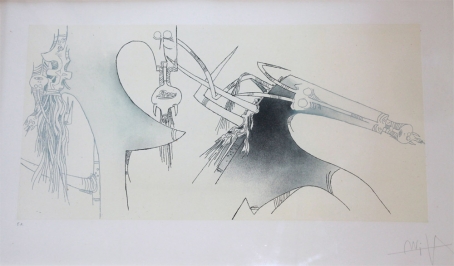
Wifredo Lam (Cuban 1902-1982)
- c.1970s
Apostroph' Apocalypse, etching and aquatint in colours, 1974, on wove paper, signed and inscribed 'E.A.' a proof aside from the edition of 100.
Wifredo Lam’s works have a rich vocabulary of symbolism which comes from his mixed heritage: Chinese, African, Indian and Spanish descent and with that, an inherited rich background of religious tradition – including Confucius, Catholicism and Santeria. Lam studied at the Academy San Alejandro in Havana from 1920-1923 and afterwards went to Madrid to study at the San Fernando Academy. He travelled widely throughout his life and was exposed to: the influence of many artists - including Matisse, Joan Miro, Fernand Leger, Max Ernst and Pablo Picasso; to the art movements of cubism in Spain and surrealism in France and was greatly inspired by the African sculpture of the Pacific Islands. It is the sum of all these influences in the images that make up his paintings: Lam combined the radical modern styles of surrealism and cubism with the iconography and spirituality of African and Cuban mythology to create his own unique body of work. From the 1950s through to the end of his life Wifredo Lam developed and perfected his printmaking techniques.
In this lithograph there are two images of the femme cheval and looking at the time it was created, it is a possible representation for the Cuban revolution, the horse no longer a victim but representing the revolutionary liberation.
Dimensions
Framed size: Height: 67cm; Width: 95cm
Enquire About this Product


